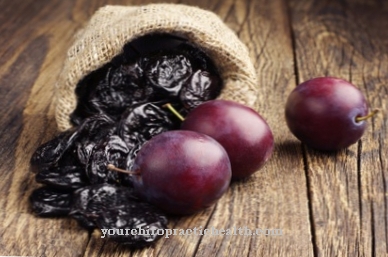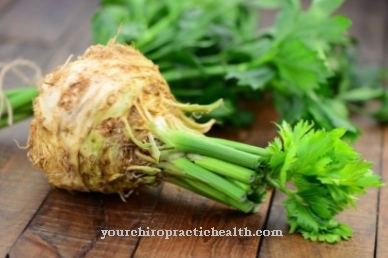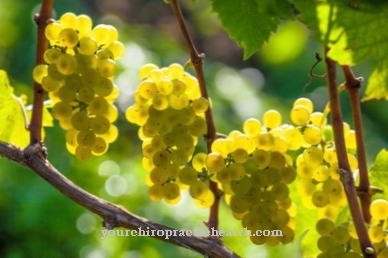The Garden black salsify is a traditional root vegetable. When peeled, it is reminiscent of asparagus plants. Hence, it becomes colloquial too Poor people's asparagus called. Other names for the vegetables are: Real black salsify, Spanish salsify or Winter asparagus.
What you should know about garden black salsify

The garden salsify comes from the genus of salsify. The vegetable is the edible root of a yellow blooming daisy family. The salsify is related to the beet and has the shape of a taproot.
The botanical name is Scorzonera hispanica. Their original distribution in Spain as well as on the Iberian Peninsula can be recognized by this name to this day. The root vegetable was introduced to Central Europe in the 17th century. Their cultivation displaced the oat root - a popular vegetable since the 13th century. The black salsify has a diameter of approx. 3 - 4 cm and is 22 - 50 cm long. A striking feature is the dark to black outer skin of the roots. This is not edible. When peeling off, a white-yellowish milky juice is produced. It emerges from the milk tubes of the root, which are injured when peeling.
The milky juice contains rubber and is therefore very sticky. This juice oxidizes quickly in the air and turns brown as a result. Nowadays, black salsify is mainly cultivated in Belgium, France and the Netherlands. The few garden black salsify that still grow wild in Germany are particularly protected according to the Federal Species Protection Ordinance. The plant is considered endangered - depending on the region. If you want to use black salsify in the kitchen, you should not harvest them wild. There are cultivated forms that can be used for this in trade and for hobby gardening. The garden black salsify is a biennial plant. In the first year it forms the rootstock, the leaf mass. It does not blossom until the second year.
The flower stems can grow to a height of 120 cm. However, the plant is only grown as an annual and harvested before the flowering stage. The harvest season begins in October and can continue throughout the winter if the ground is frost-free or until April of the following year. The roots are hardy and do not suffer any damage from ground frost. The taste of salsify is very intense. Due to its beet-like character, it is reminiscent of kohlrabi, combined with a nutty asparagus aroma - thanks to the asparagine it contains. Therefore, the black salsify can actually be used very well as a substitute for asparagus.
Importance to health
The garden salsify is a very healthy vegetable. It contains nutritional values that are as high as beans and peas. It is also enriched with many vitamins and essential minerals such as iron and calcium. The greatest benefit is their high inulin content.
It is a polysaccharide. It is broken down into fruit sugar (fructose) in the stomach. This way, no glucose is produced during the digestive process. This makes black salsify vegetables very suitable for diabetics and relieves the blood sugar level. The vegetables are also free of cholesterol. 100 g black salsify vegetables have only 17 kcal and are therefore ideal for a weight-conscious diet. Its constituent choline is an important micronutrient for regulating nerve processes.
Ingredients & nutritional values
| Nutritional information | Amount per 100 gram |
| Calories 82 | Fat content 0.2 g |
| cholesterol 0 mg | sodium 20 mg |
| potassium 380 mg | carbohydrates 19 g |
| Fiber 3.3 g | protein 3.3 g |
The real black salsify consists of 78-82% water and contains 0.4% fat. It supplies the body with the following vitamins: rethinol, thiamine, riboflavin, niacin, pyridoxine or proviatmin A as well as vitamins C, B1 and E. 100 grams of vegetables supply the body with 224 mg of potassium, 47 mg of calcium and 2.9 mg of iron . There are also sodium, phosphorus and magnesium.
Intolerances & allergies
The already mentioned inulin is responsible for the fact that the black salsify is not well tolerated by everyone. People with sensitive gastrointestinal systems can suffer from mild digestive problems after consuming the root vegetables. No other intolerances are known.
Shopping & kitchen tips
Salsify soon sprout new leaves after harvest. That is why they are quickly put on the market. When buying, make sure that the roots have grown straight. No side shoots should have been cut off in order to enhance the visual appearance.
Other damage to the outer skin should also be absent. In the other case, some of the milk juice has already leaked before it is sold. This affects the taste and the root may be dried out. The durability would then also be reduced. The easily brittle roots should be well protected against damage when being transported in the shopping bag. At home, they are best kept in the refrigerator for only a few days. The best place is the vegetable drawer. A standard refrigerator does not offer optimal storage conditions. They are at very low temperatures of 0 - 1 ° C and a humidity of 95%. Therefore, a quick consumption is advisable.
The black salsify naturally adheres to a thin layer of soil. A kitchen apron is ideal to protect your own clothing during preparation. Rubber gloves are also helpful. Otherwise the hands will be brown and sticky. First, the vegetables are cleaned with a brush under running water. A vegetable peeler is the ideal kitchen tool for removing the root bark from vegetables. There is a trick to ensure that the sticky milky juice does not have to be laboriously cleaned. Fill a large bowl with vinegar water, dip the black salsify under water and peel them there. If you don't want to use raw garden salsify (e.g. for salad), you can also blanch it.
Then the root skin can then be easily peeled off. To do this, the vegetables can be briefly boiled and then poured with cold water. The process is even more effective when boiling in vinegar water. A cooking time of 20-25 minutes is recommended here. Caraway seeds can be added to allow the aroma to develop better. Then also briefly dip in cold water. Finally peel off the bark.
Preparation tips
The garden black salsify can be used in many ways in the kitchen. As a raw vegetable, it can be grated and combined with horseradish, nuts, apples or peas to make delicious salads. Yoghurt, sour cream, mayonnaise or lemon with parsley make suitable sauces and dressings.
As a cooked side dish, black salsify can be used in all dishes that serve kohlrabi or asparagus. They go very well with the bechamel sauce. They should be cut into bite-sized pieces before cooking. Blanched salsify can be breaded and then fried. They can also be dipped in batter and fried. This transforms them into a tasty alternative to meat dishes.
So that the freshly peeled roots do not discolour before they are prepared, there are two tricks: Either place the freshly peeled root pieces in vinegar water until processing or add some flour to the water instead of vinegar. Both of these minimize unsightly oxidation.













.jpg)

.jpg)
.jpg)











.jpg)